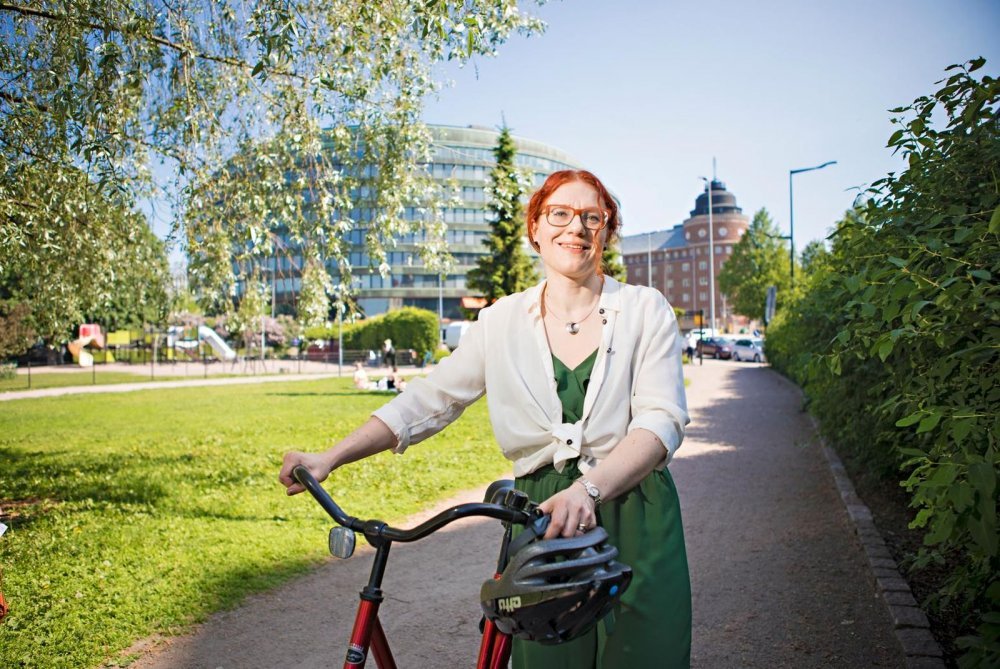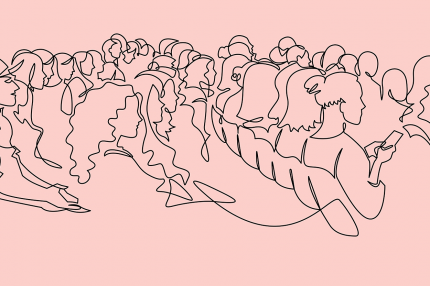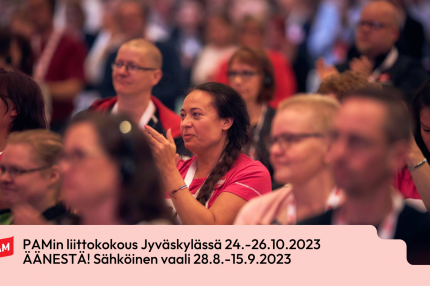Union Congress
Annika Rönni-Sällinen joined as a member 26 years ago, and now she’s President: a homecoming
”I care about PAM because I am a member myself. I want the union to have a future perspective, and that PAM is a union which is a developer and develops”, says Annika Rönni-Sällinen. Photos: Eeva Anundi
It was while working in a shop doing a summer job that Annika Rönni-Sällinen learned about collective agreements. She then went on to resolve disputes, before becoming a collective bargainer. Now she is returning to PAM as President and wants to focus on lifting membership numbers and working conditions.
Annika Rönni-Sällinen joined PAM’s predecessor, the Union of Commercial Employees in Finland, while still at high school. She had a summer job in a shop in her home town of Mänttä. Her employer suggested she became a union member, and so Rönni-Sällinen posted off the membership forms.
26 years later, at the start of this month, PAM’s Congress elected her as the union’s new President. Five other candidates were standing for the post, but in the end none of them was put forward at the actual meeting, and Rönni-Sällinen, who had broad support, was elected without a vote and to raucous applause.
She stepped on to the stage in the main hall of Messukeskus and received a bouquet of flowers from the outgoing President Ann Selin. After a moment’s emotion, Rönni-Sällinen collected herself and thanked her supporters and all the PAM members she met during her campaign in branch meetings and the like around Finland.
“It feels great to come back home”, she said.
Rönni-Sällinen previously worked at PAM for many years, but is becoming President having been Bargaining Manager at the SAK Confederation.
“Now the work begins”, as she put it in her acceptance speech.
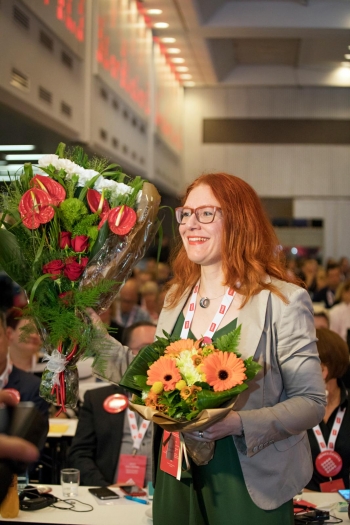
Homing in on the big picture
Rönni-Sällinen’s career started with shop work while studying, but in those early days she was also a strawberry picker, unemployment fund official and lawyer’s assistant. Shop work not only led to membership of the Union of Commercial Employees, it also taught her to be service-minded: it’s no good standing around idly, you have to ask the customers if they need assistance.
“It was a nice summer job – I was there for several summers.”
She also learned about collective agreements: both employees and employers referred to the same leaflet to see what the going rate was for different jobs, and the other rules for shop work.
And on the subject of rules, Rönni-Sällinen had started to consider studying law while at secondary school.
“I don’t really know where the idea came from. I didn’t know any lawyers. Maybe it was because my father was a shop steward and looked after employees’ interests, and also a sense of and an insistence on justice, which I have somehow always had.”
She successfully applied to study law, and graduated in spring 2002. Around that time she became a lawyer at PAM.
Some years went by, and Rönni-Sällinen went from dealing with individual disputes to another department: collective bargaining, negotiating the collective agreement for the for the hospitality sector. She later headed those negotiations as head of unit.
Moving from one department to another was easy, as Rönni-Sällinen moved to a new office on the fourth floor of PAM’s office at the time. In career and conceptual terms the move from lawyer to collective bargainer was a bigger change.
“I began to see interest representation in a much wider perspective, and I found it was my thing. I felt I wanted and was able to go beyond individual cases and influence the big picture.”
Despite this she says she often still thinks like a lawyer.
“I have to be able to compartmentalise and put things in order.”
Team work is what counts
Many things have changed in this millennium in the labour market and round the collective bargaining table. There has been a long recession, the rise of online commerce, warehouse automation and digitalisation more generally, and the arrival of the platform economy. The employers’ federation, EK, also decided that it would no longer do general incomes policy agreements, preferring to negotiate working conditions by sector.
“The end of centralised labour market agreements is a big change. In future it will be essential within the trade union movement to work together and find joint approaches. If the unions are at loggerheads, nothing good will come of it”, Rönni-Sällinen states.
”We need to make sure we are more visible for our members.”
“Another big change is that the climate in society has changed: criticism of trade unions and their work has increased in recent years. Unions didn’t have to justify their existence as much at the start of the millennium as they do now. Perhaps this is true for the world in general.”
More members
Rönni-Sällinen sees one of her most urgent missions being to increase PAM’s membership, in other words the organisation rate in service sectors.
“This will be down to PAM as a whole, and I don’t have a magic solution. We need a whole range of actions working together. To find these we need to listen to our members and the expertise of PAM’s staff.”
Another thing I want to get going on straight away is to raise the prestige of service sector work: even though this has always been on PAM’s agenda, the work goes on.
This brings us back to improving working conditions.
“We have to find new approaches to part-time work and for example zero-hours contracts, also in collective agreements. This is a high priority for PAM in terms of people’s incomes”, Rönni-Sällinen stresses.
The ground rules of the platform economy also need to be sorted out, so that those who are effectively in an employment relationship have employment protections.
Rönni-Sällinen wants PAM to be actively involved in developing Finnish working life more generally, so for example shop stewards and PAM’s staff will have to be right up to date with their skills as the world changes.
We need to make sure we are visible and are having an impact both in society and at PAM workplaces.
“I want the union to be present in day-to-day life, not somewhere far away in the head office in Helsinki. Everyone has a part to play in this, including for example activists and the union branches.”
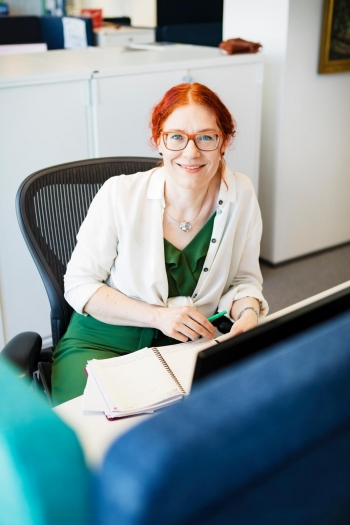
Management as coaching
As President Rönni-Sällinen is the public face of the union, but also the boss of its employees. As a manager she wants to be supportive and delegate responsibility, a bit like a coach. Being even-handed is also important.
She says that these principles mainly spring from her own experience: good managers have been inspirational, the not-so-good ones represented what she didn’t want to be.
“I have also attended management training and coaching, read up on the subject and studied for a management qualification. But many things come from experience in practice.”
“We can achieve miracles”
A day after her election, Rönni-Sällinen returns to the podium in the hall at Messukeskus, this time to give her President’s policy speech. After three long days of meetings, the Congress representatives listen carefully to how the union’s new leader sees the future.
The day of her election was emotional, but now Rönni-Sällinen gets down to business: she sets out her approach on working conditions, membership acquisition and the role of trade unions in society. She concludes, however, with an appeal and a promise:
”If we believe in us, if we believe in doing things together, if we believe we are on the side of right and are serving the future, we can achieve miracles. That’s what I hope from you all. That’s what I promise to work for.”
The speech again ends with applause, and the Congress also ends. But a new four-year period, with a new President and a new priority action programme, is just beginning.

